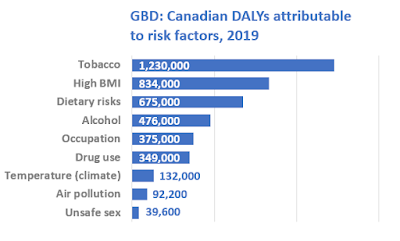Annual tobacco deaths in Canada now exceed 50,000
In October, the Lancet published updated estimates produced by the Global Burden of Disease Study group. This global research effort has been ongoing since 1990. It was original hosted at the World Bank and the World Health Organization and was more recently adopted by the Institute for Health Metrics and Evaluation (IHME).
When this study began in 30 years ago, tobacco was found to be responsible for about one-quarter (28%) of Canadian deaths, by coincidence about the same percentage as the proportion of Canadians who were smoking at that time. By 2019, smoking rates had fallen by about half (to 15%), but because of the lengthy impact of smoking, the GBD found the proportion of Canadian remained high, at 51,700 deaths or 18% of all deaths. After 30 years of public health effort, the mortality from tobacco industry products fell from one-in-four Canadian deaths to one-in-five-and-a-half.The GBD looked at the death impact of three different sets of risk factors: behavioural, environmental and occupational and metabolic risks. Of Canada's 284,000 deaths last year, this study attributed 162,000 deaths to 87 risk factors. Among the individual risk factors in these categories, tobacco use was the single largest individual risk to contribute to Canadian mortality.
The GBD estimated of 51,700 deaths attributable to tobacco use (active and passive smoking and chewing tobacco) is a somewhat higher number than the estimate published earlier this year by the Canadian Centre for Substance Use of 47,700 deaths caused by smoking in 2017.1.2 million Canadian life years lost to tobacco in 2019
Another measure considered in this report was the loss of heatlhy life years to each risk factor (Disability-Adjusted Life Year, DALY). Even though tobacco-caused deaths are typically later in life, tobacco was nonetheless the predominant individual cause of Canadian DALY's. As with deaths, tobacco was the largest individual contributor to healthy life years lost, with the more than a million life years lost to tobacco in 2019 representing about 10% of the Canada's total DALY burden.
A separate analysis which was published by this group looked at deaths from specific diseases and injuries. Smoking, for example, is a risk factor for lung cancer, stroke, COPD and a host of other diseases. One report focused, the other on disease and injury. This research was pre-COVID, and did not include the 2 million (and climbing) COVID-19 deaths world-wide or the 18,000 (and climbing) deaths in Canada.
Data taken from:
GBD 2019 Risk Factor Collaborators. Global burden of 87 risk factors in 204 countries and territories, 1990–2019: a systematic analysis for the Global Burden of Disease Study 2019. Lancet. October 17, 2020. Data for Canada can be downloaded here.GBD 2019 Diseases and Injuries Collaborators. Global burden of 369 diseases and injuries in 204 countries and territories, 1990–2019: a systematic analysis for the Global Burden of Disease Study 2019. Lancet, October 17, 2020.


